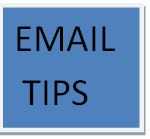Personalized subject lines can backfire in emails
A good personalized subject line can boost your results. But mess up the personalization, and you’ll lose.
Characteristics of good personalized subject lines
It’s great to tweak your email subject line to appeal to a specific recipient. For example, if you know the recipient’s hot button, include it in the subject line.
Another approach is to name the person or their organization in your subject line. There’s some data to support this approach. For example, “Including the recipient’s name in the email subject line increased open rates–some by as much as 42%,” according to Experian data cited in “How Pairing Personalization & Automation Can Skyrocket Email Conversions” on the Kissmetrics blog. I assume there’s a similar effect when you personalize other information in the subject line.
But you need to proofread carefully so you don’t personalize for the wrong recipient. A bad subject line (and email body) can send your email to spam. A badly personalized subject line can doom your email to head into your target readers’ spam folders. That’s true even if your email is relevant to the recipients.
Example of badly personalized subject line
Today’s blog post is inspired by an email that was sent to me in my role as the editor of the NAPFA Advisor magazine. I found it when reviewing my spam folder. The subject line read “Idea for timely content/article for ZZZ Magazine.” The subject line said “ZZZ Magazine” where it should have said “NAPFA Advisor.” I don’t know if that’s why the message went into spam. But the wrong name in the subject line didn’t inspire me to click through on the email.
Putting the wrong name in the subject line puts you on the quick path to an email trash folder.
How to avoid mistakes in your personalized subject line
Proofread, proofread, proofread. That’s the best way to avoid mistakes in your personalized subject line.
Another possibility is to automate the inclusion of personalized information in your subject line. Some email programs allow you to do that in a twist on the mail merges you may know from word processing.
Contrary view on personalized subject lines
Although I argue for personalization in this post, the evidence is mixed on adding the recipient’s first name to your email subject line.
In its FAQ on “How do I personalize the subject line (or content) of my email?“, Benchmark Email says it “does not advocate adding a contact’s first name in the subject line of your emails. Doing so may lead to an increase of spam complaints, as spammers are known for using personal data in the subject line of emails.”
A MailChimp blog post says that subject lines using first names performed worse than those without first names. The blog suggests that names take up space without adding value, according to “Personalizing Subject Lines – Does It Help Or Hurt Open Rates?” The post appeared in 2008, so it’s possible that things have changed since then.
What’s my take on this debate? Rote personalization—like simply adding the recipient’s name to the subject line—may not work. Personalization that truly appeals to the individual’s interests is powerful. I would have responded differently to an email that correctly named my magazine in its subject line.
Image courtesy of pakorn at FreeDigitalPhotos.net.







My suggestion is to individualize – make the subject line distinct to the individual recipient.
Sue,
Yes, you are right.
Thanks for commenting! It’s always nice to hear from you.